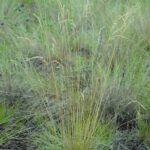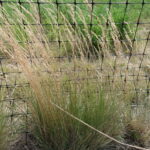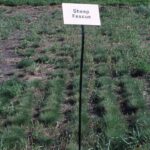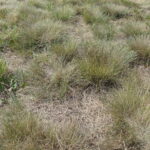Hard Fescue / Sheep Fescue
Festuca trachyphylla
General Description
Hard fescue is an introduced, cool season bunchgrass with fibrous roots. Hard fescue is not native to North America and was introduced from Europe. There is some confusion about the scientific naming of the species, mostly because in older works it was considered a subspecies of sheep fescue (Festuca ovina var. duriscula). Sheep fescue is also introduced from Europe, but is closely related to the red fescue (F. rubra) complex, which is native to North America. They are grouped together here as characteristics are very similar.
Type
Tame grass.
Origin
Europe and Eurasia.
Longevity
Hard fescue is long-lived.
Use
Hard fescue is used primarily for erosion control, stabilization of roadsides and skid trails, weed and invasive plant suppression, and groundcover in orchards. It is sometimes used in forage applications although less preferred than other species.
Hard fescue is also grown for seed production in the Peace River Region.
Optimal Time of Use
Hard fescue remains green through the growing season, and may be used in spring, summer and fall. Hard fescue should not be grazed in the year of establishment.
Recovery After Use
Primarily spring and fall growth dependent on moisture conditions.
Forage yield will depend on site conditions and precipitation.
Palatability/Nutritional Value
It is only fair forage value compared to other species. Forage quality is typically better on more moist sites and can be improved with fertilization.
Annual Precipitation min/max (mm)
300mm / 760mm
Drought Tolerance
Hard fescue “Durar” has moderate drought tolerance, but is less drought tolerant than sheep fescue.
Flooding Tolerance
Low tolerance.
Winter Hardiness
Hard fescue has moderate winter hardiness and cold tolerance.
Soil Texture Preference
Hard fescue prefers fine to medium textured soils that are well drained.
Erosion Control
Hard fescue is highly suitable for erosion control because of its extensive root system once it is established.
Salinity Tolerance
No salinity tolerance.
Acidity Tolerance
Low to moderate tolerance, but prefers pH levels of 6.0 to 8.0.
Alkalinity Tolerance
Low tolerance.
Seeds per kg
1,243,000 seeds/kg (565,000 seeds/lb)
Suggested Mixtures
Other species may be included depending on management objectives.
Ease of Establishment
Seedlings are delicate and may be susceptible to soil crusting. Spring seeding may be preferable. Plants remain small in the first year. Typically cover increases substantially in the second year of establishment. Suitable for broadcast applications.
Competitiveness
Hard fescue is very competitive, and can increase and become dominant once established.
Management Considerations
Fertilization may help maintain stands on heavily used areas.
BC Rangeland Seeding Manual, USDA Plants Database
Sheep fescue and hard fescue are adapted to all zones of the Central Interior. Sheep fescue and hard fescue are very persistent especially in the dry southern part of the region, i.e., the Bunchgrass and Interior Douglas-fir zones, and may invade native plant communities in these areas.
Sheep fescue and hard fescue are very persistent in the drier zones of the region, i.e., the Bunchgrass, Ponderosa Pine and Interior Douglas-fir zones, and may invade native plant communities in these areas.
Hard fescue and sheep fescue are grown for seed production in the area.



